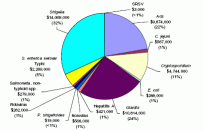Approaches To Estimating the Waterborne Disease Outbreak Burden In the U.S.: Uses and Limitations of the Waterborne Disease Outbreak Surveillance System (External Review Draft)
Notice - This site contains archived material(s)
Archive disclaimer
Archive
disclaimer
Archived files are provided for reference
purposes only. These files are no longer maintained by the Agency and may be outdated. For
current EPA information, go to www.epa.gov. It is EPA's policy to
support reasonable accommodation to persons with disabilities, pursuant to the Rehabilitation
Act of 1973, 29 U.S.C. 791. If you need assistance with accessing archived files, contact
EPA's Reasonable Accommodations
or submit a request using the Contact Us form.
Abstract
 Information about U.S. Waterborne Disease Outbreaks (WBDOs) is voluntarily reported by state, territorial and local public health agencies to the Centers for Disease Control and Prevention (CDC). CDC and EPA jointly maintain the WBDO database that summarizes the information collected through this WBDO Surveillance System. The WBDO database describes outbreak attributes including, among other things, the drinking water system deficiency, the etiologic agent, and the number of individuals who became ill. Underreporting of WBDOs is assumed but the magnitude of underreporting is unknown.
Information about U.S. Waterborne Disease Outbreaks (WBDOs) is voluntarily reported by state, territorial and local public health agencies to the Centers for Disease Control and Prevention (CDC). CDC and EPA jointly maintain the WBDO database that summarizes the information collected through this WBDO Surveillance System. The WBDO database describes outbreak attributes including, among other things, the drinking water system deficiency, the etiologic agent, and the number of individuals who became ill. Underreporting of WBDOs is assumed but the magnitude of underreporting is unknown.
Impact/Purpose
Status
Citation
History/Chronology
| Date | Description |
|---|---|
| Sep 2006 | EPA released the External Review Draft Document for a 30-day Public Comment Period. |
| Oct 2006 | EPA held an External Peer Review Meeting on the draft document in late October. Following the external peer review and public comment period, EPA will incorporate these comments into the final report. |
Additional Information
- Oct 22, 2004 surveillance summary for 2001/2002 (PDF, 48pp)
- Nov 22, 2002 surveillance summary for 1999/2000 (PDF, 52pp)
- May 26, 2000 surveillance summary for 1997/1998 (PDF, 44pp)
This download(s) is distributed solely for the purpose of pre-dissemination peer review under applicable information quality guidelines. It has not been formally disseminated by EPA. It does not represent and should not be construed to represent any Agency determination or policy.
